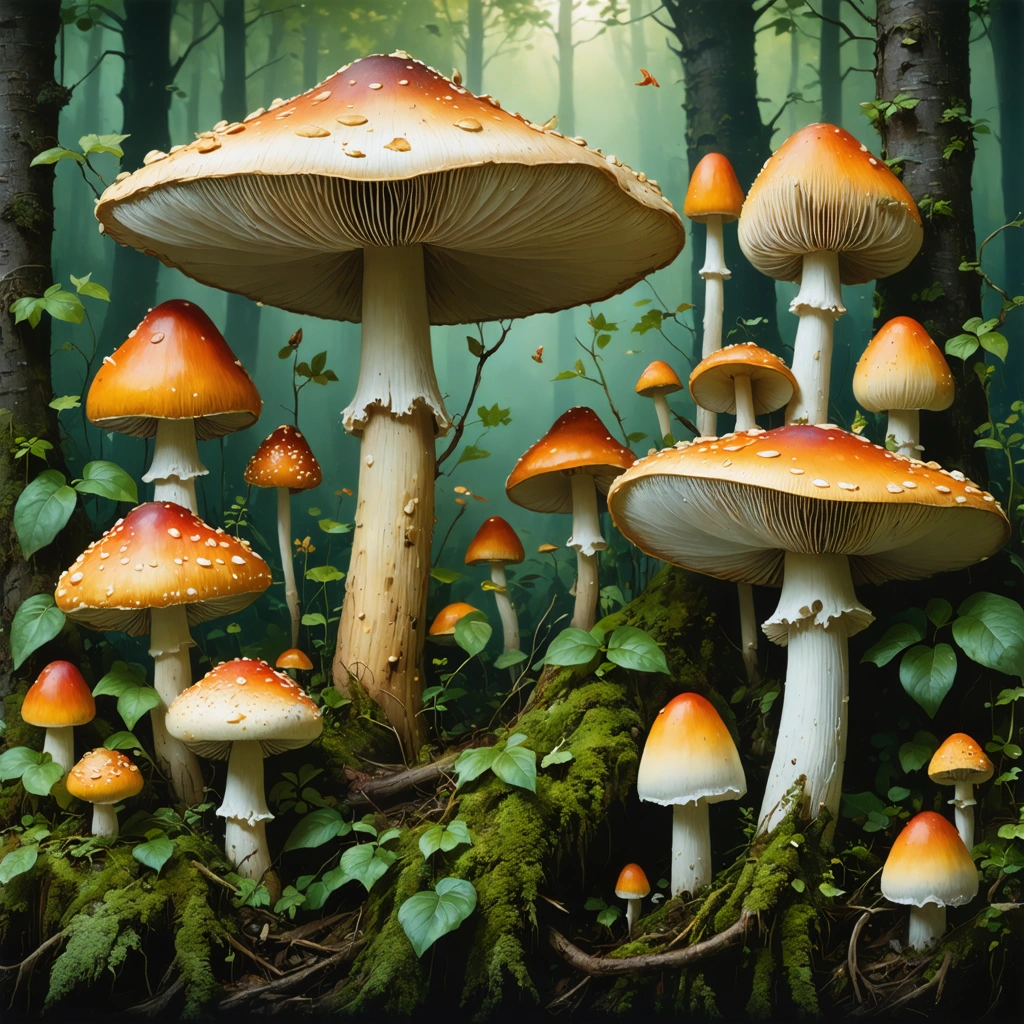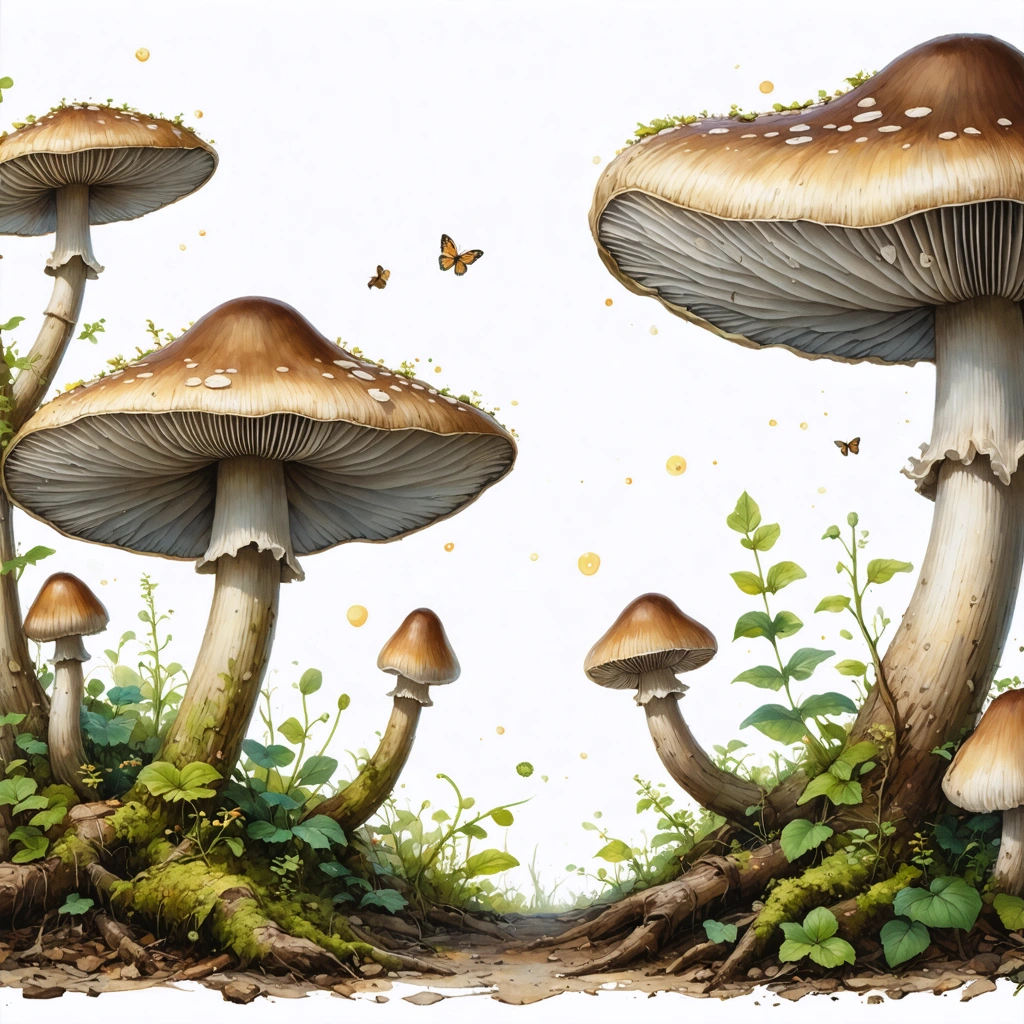
When Mushrooms Move Beyond the Forest Floor
Have you ever paused to marvel at the quiet, unassuming mushroom sprouting from damp soil or nestled beneath a canopy of leaves? These little fungi have long been nature’s understated architects, quietly shaping ecosystems and fueling imaginations. Yet, for all their ecological importance, mushrooms often remain overlooked in the world of art and design—until recently. A fresh wave of creatives is turning to mushroom drawing and fungi art, breathing new life into earthy aesthetics and inspiring trends that celebrate nature’s whimsy in bold, unexpected ways.
But why the sudden fascination with these fungal forms? And how does mushroom art transcend mere botanical illustration to become a vibrant language of creativity and sustainability? If you’ve ever struggled to find design inspiration that feels both grounded and playful, or if you’re curious about how natural motifs can be woven seamlessly into modern aesthetics, this exploration of fungi art might just spark your next creative breakthrough.
The Overlooked Muse: Why Mushroom Art Deserves a Spotlight
For decades, much of the art world has gravitated towards grandiose floral patterns or majestic trees when drawing inspiration from nature. Mushrooms, with their often diminutive size and ambiguous shapes, don’t immediately scream “artistic muse.” Yet, this very subtlety can be a double-edged sword—offering artists a fresh canvas for imagination or leaving the fungi trapped in the shadows of more traditional natural subjects. Mushroom drawing, with its delicate curves and intriguing textures, invites a closer look, encouraging a more intimate connection with the natural world.
What’s particularly compelling about fungi art is its inherent blend of the familiar and the fantastical. Mushrooms range from the understated to the wildly psychedelic, embodying forms that can be both scientific and surreal. This duality challenges artists to push boundaries, merging botanical accuracy with imaginative flair. However, many creatives initially hesitate, unsure how to capture this balance without veering into cliché or kitsch. As a result, fungi art has long been an underutilized resource in earthy design trends—and that’s a missed opportunity.
Why Should Designers and Artists Care?
In today’s design landscape, authenticity and connection to nature resonate more than ever. Consumers increasingly seek products, visuals, and spaces that reflect ecological mindfulness and invite a sense of calm rooted in the organic world. Mushroom drawing offers a perfect vehicle for this. Unlike the predictable leaf or flower, mushroom forms provide unexpected silhouettes and textures that can evoke curiosity, wonder, and even a touch of mystery.
Moreover, fungi art taps into a broader cultural moment. From foraging communities to psychedelic research, mushrooms have recently entered the public consciousness as symbols of healing, transformation, and ecological balance. Translating these themes into visual art and design not only enriches aesthetics but also aligns creative work with meaningful narratives—a combination that is highly valued by today’s audiences.
From Sketch to Style: How Mushroom Drawings Shape Contemporary Design
Imagine a cozy living room adorned with cushions featuring hand-drawn mushroom motifs, or a boutique brand logo inspired by the intricate lines of a mushroom cap. This is no longer a niche fantasy but a growing trend. Mushroom art is making waves in graphic design, fashion, home décor, and digital media—each sector embracing the humble fungus in its own unique way.
- Graphic Design: Mushroom drawing lends itself beautifully to branding that wants to evoke an earthy, artisanal feel. Its organic shapes break away from rigid geometry, offering softness and warmth.
- Fashion: From printed fabrics to embroidered details, fungi art brings playful yet sophisticated elements to wearable design, often paired with natural dyes and sustainable materials.
- Home Décor: Wallpapers, ceramics, and textiles inspired by mushroom art create inviting, nature-infused interiors that foster relaxation and creativity.
- Digital Art: Illustrators and animators explore fungi’s surreal potential, blending scientific accuracy with imaginative storytelling to craft immersive experiences.
What’s exciting is that mushroom drawing is accessible to artists of all skill levels. Whether you’re a seasoned illustrator or a hobbyist doodling in the margins, this subject invites experimentation with line, color, and form. The whimsy of fungi encourages playfulness—no need to be exacting, just expressive.
Looking Ahead: The Mushroom Art Movement
As more artists and designers embrace fungi art, we’re witnessing a cultural shift toward celebrating the small wonders of our natural world. Mushroom drawings no longer serve merely as botanical studies but as symbols of creativity, resilience, and ecological harmony. This movement is not just about aesthetics; it’s about reconnecting with the earth in ways that inspire sustainable living and mindful creativity.
So whether you’re an artist searching for fresh motifs, a designer aiming to align your work with eco-conscious values, or simply someone enchanted by the curious world of fungi, mushroom art offers a rich, fertile ground for exploration. Join us as we delve deeper into the whimsical world of mushroom drawing and uncover how fungi art is reshaping the landscape of earthy, creative design trends.

Mushroom Art: Fungi’s Whimsy Inspiring Earthy, Creative Design Trends
What is Mushroom Art and Why is it Becoming Popular?
Mushroom art refers to creative works that use the imagery, shapes, and symbolism of mushrooms and fungi as central motifs. This includes mushroom drawing, fungi art, and other visual representations that capture the organic, whimsical, and sometimes mystical qualities of fungi. Over recent years, mushroom art has surged in popularity across various creative fields, including illustration, fashion, graphic design, and interior décor.
The rising interest in mushroom art can be attributed to several cultural and environmental trends. Firstly, there is a growing fascination with nature and biophilia—people’s innate connection to natural elements. Mushrooms, with their diverse forms and mysterious life cycles, evoke a sense of wonder and curiosity. Secondly, the rise of sustainability and eco-consciousness in design encourages the use of organic motifs that remind us of ecosystems and the interconnectedness of life.
Finally, mushrooms have long held symbolic meanings across cultures — representing transformation, magic, and even psychedelic experiences — which adds layers of narrative richness to fungi art that appeals to creatives and consumers alike.
How Are Mushroom Drawings Created and What Techniques Are Common?
Mushroom drawings can range from highly realistic botanical illustrations to stylized, abstract, or whimsical interpretations. Artists use a variety of mediums and techniques depending on their vision and the intended application of the art.
- Traditional mediums: Pencil, ink, watercolor, and gouache are popular for detailed and textured mushroom art. Botanical illustrators often use fine line work and delicate shading to capture the intricate gill patterns and cap textures.
- Digital art: Many contemporary artists create mushroom drawings digitally using tablets and software like Adobe Photoshop and Procreate. Digital tools allow for vibrant color palettes, layering effects, and easier revisions.
- Mixed media: Combining drawing with collage, printmaking, or even textile elements can add depth and tactile interest to fungi art.
Artists often study real mushrooms in nature or reference scientific mycology texts to ensure accuracy. However, many also embrace the imaginative and surreal qualities of mushrooms, emphasizing their fantasy-like shapes, glowing colors, or mythical associations.
In What Ways is Fungi Art Influencing Modern Design Trends?
Fungi art is inspiring a wide array of design trends that emphasize natural beauty, playfulness, and sustainability. Here are some key areas where mushroom drawing motifs are driving creative innovation:
- Fashion and textiles: Mushroom patterns appear on clothing, accessories, and home textiles, often highlighting earthy tones and organic shapes that promote eco-friendly aesthetics.
- Graphic design and branding: Startups and brands in wellness, organic foods, and eco-products increasingly use fungi-inspired logos and packaging to communicate natural purity and creativity.
- Interior design: Mushroom art murals, prints, and decor items bring warmth and whimsy to living spaces. The mushroom’s natural form complements biophilic design principles, which are shown to improve wellbeing.
- Contemporary art and installations: Artists create immersive environments that mimic fungal ecosystems, exploring themes of decay, regeneration, and symbiosis.
Industry statistics support these trends. For example, according to a 2023 survey by the Pantone Color Institute, earthy and natural motifs, including fungi, have grown 25% in popularity in graphic design and product packaging since 2020. Moreover, Etsy and other artisan platforms have reported a 40% year-over-year increase in mushroom-themed artwork and products, underlining consumer demand.
What Cultural and Symbolic Meanings Do Mushrooms Carry in Art?
Mushrooms are rich in symbolism, which adds depth to mushroom art and fungi art. Across cultures, they have been associated with:
- Transformation and rebirth: Mushrooms often appear after rain, symbolizing renewal and cycles of life.
- Magic and mystery: Their sudden appearance and hallucinogenic properties have linked them to mystical experiences and folklore.
- Connection and symbiosis: Mycorrhizal fungi form underground networks connecting trees, symbolizing unseen relationships and communication.
- Health and nature’s medicine: Many cultures use mushrooms for their medicinal properties, reflecting themes of healing in fungi art.
These symbolic layers encourage artists and designers to explore deeper narratives beyond the surface beauty of mushroom drawing, making fungi art a powerful medium for storytelling and emotional engagement.
How Can Beginners Start Creating Their Own Mushroom Drawings?
For those inspired by fungi’s whimsy and eager to try mushroom drawing themselves, here are some practical steps:
- Observe real mushrooms: Visit local parks or forests to study different species, noting shapes, textures, and colors.
- Start simple: Begin with basic shapes — circles for caps, cylinders for stems — and gradually add details like gills and spots.
- Use reference images: Botanical books, online galleries, and scientific illustrations provide valuable guidance.
- Experiment with mediums: Try pencil sketches, ink outlines, or watercolors to discover what suits your style.
- Practice stylization: Once comfortable, add whimsical elements such as exaggerated shapes, patterns, or imaginative colors.
- Engage with online communities: Platforms like Instagram, Pinterest, and art forums offer inspiration and feedback.
By combining observation, practice, and creativity, anyone can develop their own unique approach to mushroom drawing and contribute to the growing world of fungi art.
Conclusion
Mushroom art embodies a fascinating intersection of nature, creativity, symbolism, and design innovation. From detailed mushroom drawings to expansive fungi art installations, this trend offers endless inspiration for artists, designers, and enthusiasts. Its growing prominence in fashion, graphic design, and interior décor underscores a broader cultural shift toward appreciating natural forms, ecological awareness, and imaginative storytelling.
By understanding the techniques, cultural meanings, and design applications of mushroom art, creatives can more deeply engage with this whimsical, earthy motif and harness its potential to inspire meaningful, beautiful work.


